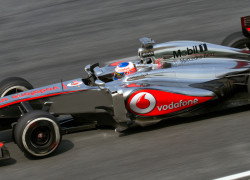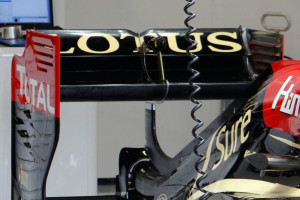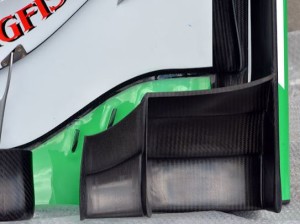
In this second part of our F1 technical round up we take a look at McLaren, Lotus and Force India.
McLaren
McLaren have had a very tough start to the season. Their 2013 car is nowhere near their 2012 contender, the MP4-27. With a whole new front suspension setup, McLaren have had their fair share of hardship this season.
At the front of the car, McLaren have kept most of the design of their front wing from the 2012 car. While other teams are are sporting 5 to 7 tiered wings, the front wing on the McLaren has three tiers. This configuration has hardly been touched throughout the season and they’ve been running the same front wing for the past few races.
 Around the side of the car, they’ve ditched the horizontal side pod airflow conditioners at the top of the side pods for curved vertical vortex generators from the Spanish Grand Prix with the Red Bull type “D” wing to condition the flow around the side of the car.
Around the side of the car, they’ve ditched the horizontal side pod airflow conditioners at the top of the side pods for curved vertical vortex generators from the Spanish Grand Prix with the Red Bull type “D” wing to condition the flow around the side of the car.
Towards the rear of the car, they’ve tightened up the bodywork in the coke bottle region. They’ve added a vertical slot on the rear wing endplate to minimise tyre squirt.
With McLaren now concentrating on next season’s car, it is unlikely that they will make many further updates to the current car. We should see development parts for the 2014 car surface during free practice in the last few races.
Lotus F1 team
Lotus kicked off their 2013 campaign very well with a victory in the F1 season opener in Australia and Kimi Riakkonen has also consistently scored points for the Enstone based team.
 Lotus is running a 4 tiered front wing with a split vertical element. The split element helps to direct the airflow whenever the car changes direction. They’ve also added a curved horizontal vane on the front wing endplate to help create a vortex of air around the side of the car.
Lotus is running a 4 tiered front wing with a split vertical element. The split element helps to direct the airflow whenever the car changes direction. They’ve also added a curved horizontal vane on the front wing endplate to help create a vortex of air around the side of the car.
In a few races this season, they’ve run a bulge on the underside of the nosecone, which helps the airflow along the underside of the car.
Lotus are also running a similar cross-under tunnel to Red Bull, where the air from the outer edge of the side pods is directed to the center of the car to exit at the diffuser.
 The one big F1 technical development which Lotus were testing throughout the second half of the 2012 season and again at the British and German Grands Prix is their passive DRS or DRD.
The one big F1 technical development which Lotus were testing throughout the second half of the 2012 season and again at the British and German Grands Prix is their passive DRS or DRD.
The device works by receiving high speed air from intakes around the air box above the driver’s head. The air then travels down the back of the car and exits from a periscope type outlet just below the rear wing, which then stalls the rear wing at high speed. This reduces the rear wing’s effect and it gives the car a higher speed.
The trick to this device lies in when the wing stalls. You don’t want it to stall half-way through a high speed corner. Nor do you want to it not to stall down a straight where DRS is not active. It’s quite tricky to get it right but it looks as if Lotus have found a way around this problem. They’ve added a bleed pipe that exits just above the monkey seat. The reason that this is legal is that it requires no input from the driver to activate. It uses the speed of the air coming into the airbox to stall the wing.
Force India
Force India have been the strongest of the mid-field teams so far this season. They’re currently even ahead of McLaren in the Constructors’  Championship.
Championship.
As far as their F1 technical upgrades go, Force India have a 4 tiered front wing with the same vertical guide vanes on the main plane of the wing that we can see on the Red Bull.
These guide vanes work in conjunction with the guide vanes on the back of the wing to guide the air to the edge of the wing for better vortex generation.
On the underside of the nose cone, they have followed the top teams in splitting the turning vanes. The split in the turning vanes helps to keep the airflow under the car a bit more constant when the car changes direction.
And around the back of the car, they too, have a slot in the end plate of the rear wing that helps to minimise the tyre squirt.
And that’s it for part two of our F1 technical Round Up. In part three we’ll look at the Sauber, Toro Rosso, Williams, Caterham and Marussia F1 teams.


